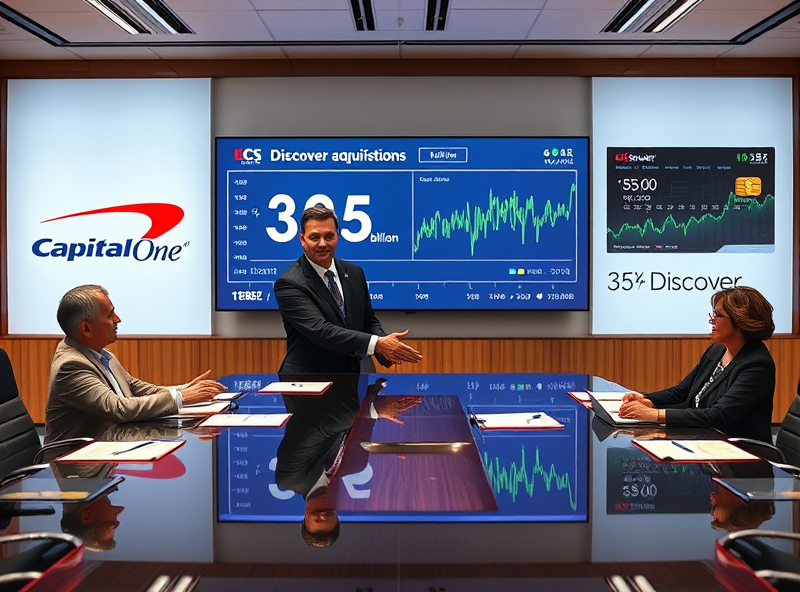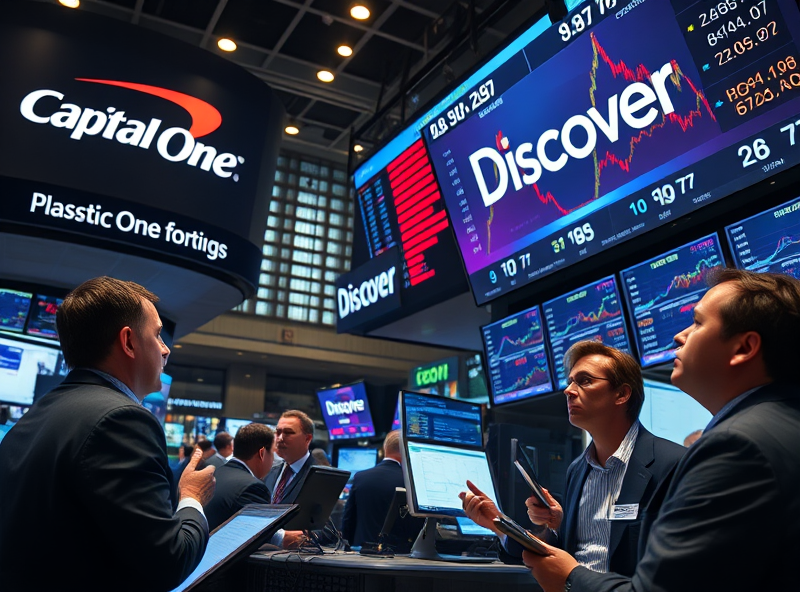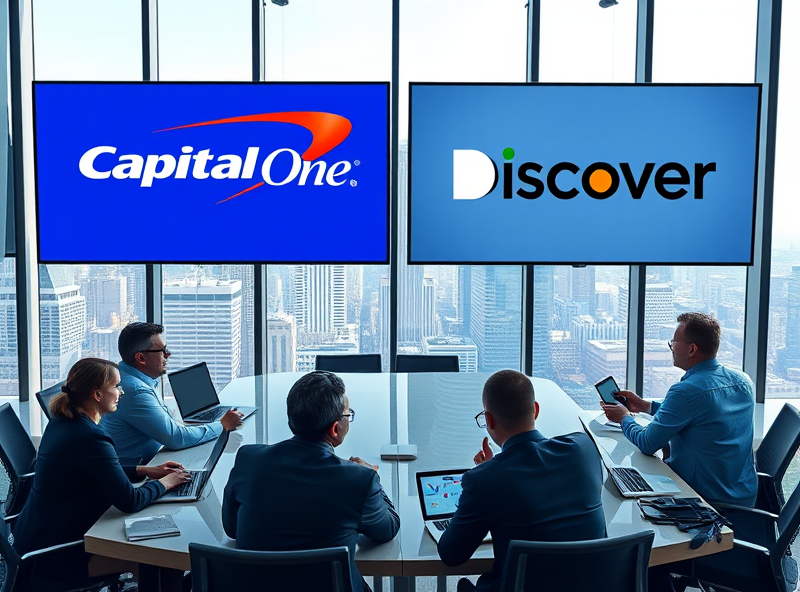
Capital One’s Discover Acquisition: Strategy, Stock, and Market Impact
Strategic Goals Behind the Discover Acquisition

Capital One’s recent announcement to acquire Discover Financial Services marks a pivotal moment in the U.S. financial landscape. While it may seem like just another merger, the strategic goals behind this move reveal a much deeper transformation in the credit card and payments industry.
At the heart of this acquisition is Capital One’s ambition to become a more vertically integrated financial powerhouse. By acquiring Discover, Capital One gains direct access to a payment network—something only a few U.S. banks possess. This move allows Capital One to reduce its reliance on third-party networks like Visa and Mastercard, giving it more control over transaction data, costs, and customer experience.
Another key strategic goal is data ownership and optimization. Discover’s payment network processes billions of transactions annually. By integrating this data with Capital One’s existing AI and machine learning capabilities, the company can better personalize offerings, improve fraud detection, and optimize credit risk models. This translates into smarter lending decisions and more tailored customer experiences.
Additionally, the acquisition opens up international growth opportunities. While Discover’s global footprint is smaller than Visa or Mastercard, it has established partnerships with international networks. Capital One can leverage these relationships to expand its reach and compete more effectively on a global scale.
Lastly, this deal is a long-term bet on digital transformation. As the financial industry moves toward embedded finance and digital wallets, owning the infrastructure behind payments gives Capital One a significant edge in innovating new products and services.
In summary, this acquisition is not just about scale—it’s about strategic control, data leverage, and future-proofing the business in a rapidly evolving financial ecosystem.
For more on the acquisition, you can read the official press release from Capital One: https://www.capitalone.com/about/newsroom/discover-acquisition-announcement/
Short-Term Stock Impact and Market Reactions

Capital One’s recent announcement to acquire Discover Financial Services has stirred notable short-term reactions in the stock market. While such large-scale acquisitions often aim for long-term strategic growth, they can trigger immediate volatility due to investor sentiment, regulatory uncertainty, and integration risks.
In the days following the announcement, Discover’s stock saw a significant uptick—reflecting investor optimism about the acquisition premium and potential synergies. On the other hand, Capital One’s shares experienced a modest dip, a common short-term reaction when an acquiring company takes on new financial and operational risks.
This kind of market behavior is not unusual. Historically, acquiring firms often face short-term stock pressure as investors digest the cost of the deal and its impact on balance sheets. In contrast, the target company typically benefits from a valuation boost, especially if the offer includes a premium over its current market price.
For investors, it’s important to look beyond the initial price swings. Analysts suggest evaluating the strategic rationale behind the deal, the financial health of both companies, and how the merger aligns with broader industry trends—like the growing importance of digital banking and payment networks.
The Discover acquisition could position Capital One to compete more directly with giants like JPMorgan Chase and American Express by expanding its credit card network and customer base. If executed well, this move may strengthen Capital One’s long-term market position, despite short-term turbulence.
For a deeper dive into how markets typically react to major M&A deals, you can refer to this analysis by the Harvard Business Review: https://hbr.org/2016/03/why-do-so-many-mergers-fail
Long-Term Value and Analyst Projections

Capital One’s acquisition of Discover is more than just a major shake-up in the credit card and banking industry—it’s a long-term strategic move that analysts believe could redefine the competitive landscape. While the short-term market reaction was mixed, with some investors concerned about integration risks, many experts are optimistic about the deal’s long-term value.
One of the key benefits lies in the expanded customer base and data assets. Discover brings with it a large, loyal user base and a proprietary payments network, which could allow Capital One to reduce its reliance on third-party networks like Visa and Mastercard. This vertical integration may result in cost savings and improved profit margins over time.
From a financial standpoint, analysts project that the deal could enhance Capital One’s earnings per share (EPS) within a few years post-integration. According to Morningstar, the combined entity could achieve better operational efficiency and scale economies, potentially leading to higher returns on equity (ROE) and long-term shareholder value. Additionally, the merger could position Capital One as a stronger competitor against giants like JPMorgan Chase and American Express.
For consumers, this could mean more innovative financial products and potentially lower fees, as the combined company leverages its expanded capabilities. For investors, keeping an eye on regulatory approval and integration milestones will be key to assessing the true value of this acquisition.
For more detailed financial analysis, you can refer to Morningstar’s coverage: https://www.morningstar.com/stocks/xnys/cof/quote
Challenges, Competitors, and Regulatory Hurdles

Capital One’s proposed $35 billion acquisition of Discover Financial Services is a bold move to reshape the U.S. credit card and payments landscape. However, this ambitious deal faces several significant challenges that could impact its success.
First, let’s talk about regulatory scrutiny. The merger would combine two major players in the credit card market, raising antitrust concerns. The U.S. Department of Justice and the Consumer Financial Protection Bureau are likely to examine whether the deal could reduce competition, increase fees, or limit consumer choice. Given the current regulatory climate, where large mergers are often met with skepticism, Capital One must prepare for a lengthy and detailed review process.
Second, competition in the financial services industry is fiercer than ever. Giants like JPMorgan Chase, American Express, and fintech disruptors such as PayPal and Square are continuously innovating. Capital One and Discover will need to demonstrate how their combined strengths—Capital One’s marketing and digital banking expertise with Discover’s payment network—can create value without stifling innovation or consumer benefits.
Third, integration risks cannot be overlooked. Merging two large financial institutions involves aligning technology systems, corporate cultures, and customer service models. Any misstep could lead to service disruptions, customer dissatisfaction, or operational inefficiencies.
Lastly, public perception and political pressure could influence the deal’s trajectory. With growing concern over financial consolidation and consumer protection, lawmakers and advocacy groups may push back against the merger.
In summary, while the Capital One-Discover deal has strategic potential, it must overcome substantial regulatory, competitive, and operational hurdles. For investors and consumers alike, staying informed about these developments is key to understanding how this acquisition could reshape the financial services landscape.
For more on the regulatory perspective, you can refer to the Federal Trade Commission’s merger guidelines: https://www.ftc.gov/legal-library/browse/antitrust-guidelines/horizontal-merger-guidelines







